New Lexus RZ 450e – EV / elbil

| From Lexus: WORLD PREMIERE OF THE ALL-NEW LEXUS RZ |
- Lexus’ all-new battery electric SUV constructed on a dedicated BEV platform
- Introduction of advanced technologies that enhance the Lexus Driving Signature handling and performance
- Optional One Motion Grip steer-by-wire system with steering yoke – a world first
- Lexus e-Axles with innovative DIRECT4 all-wheel drive torque control system
- Lexus “Next Chapter” design realises the opportunities of a BEV, including a new Lexus spindle body
- Evolution of the Lexus Tazuna concept for a fully focused driver’s cockpit
- New technologies enhance life on board, including dimmable panoramic roof and radiant heaters
- Full suite of safety and driver assistance features, including Lexus’ Safe Exit Assist preventing door opening into the path of vehicles and cyclists approaching from the rear
The new Lexus RZ 450e is now available for online reservations. You will be redirected to your local Lexus website for markets where online reservation is available.
 The RZ 450e is an all-new battery electric SUV, the first Lexus electric vehicle to be developed from the ground up. It is not a vehicle that simply adopts battery electric power in place of a conventional engine; it goes much further to realise the exciting potential of new technologies that enhance performance and driving pleasure, true to the Lexus Electrified philosophy.
The RZ 450e is an all-new battery electric SUV, the first Lexus electric vehicle to be developed from the ground up. It is not a vehicle that simply adopts battery electric power in place of a conventional engine; it goes much further to realise the exciting potential of new technologies that enhance performance and driving pleasure, true to the Lexus Electrified philosophy.
Chief Engineer Takashi Watanabe explains: “Our vision is to use electrification technology as a means to enhance basic vehicle performance, so that we can continue to pursue driving pleasure for all future generations.”
First and foremost, the RZ is a Lexus, retaining all the fine qualities of performance and craftsmanship associated with the brand. The company has leveraged its wealth of vehicle electrification experience to deliver the benefits of a BEV with the essential refinement and driving experience that are unique to its brand. This is witnessed, for example, in an advanced drivetrain featuring optional by-wire steering with a new One Motion Grip yoke and front and rear e-Axles that work in conjunction with Lexus’ new DIRECT4 all-wheel drive torque control. The fundamentals of handling and responsiveness are secured with a dedicated new electric vehicle platform, which brings excellent body rigidity, a low centre of gravity and a long wheelbase. A powerful lithium-ion battery unit is fully integrated in the chassis, beneath the cabin floor, its quality finely controlled to ensure performance is maintained long-term.
The platform and battery electric drivetrain also open up new freedoms in design. The exterior reinterprets the signature Lexus spindle shape in the vehicle’s body, while the interior is a light and open space that is both simple and luxurious, expressing Lexus Omotenashi hospitality and Takumi craftsmanship.
With its zero-emission performance, the RZ will help Lexus in its progress towards carbon neutrality and a sustainable mobility society. Here, the focus is not just on the car’s performance on the road; it embraces its entire lifecycle, from parts procurement, manufacturing and ownership through to eventual disposal. Already new methods have been adopted at Lexus’ Motomachi factory, the RZ production centre, in the processes that produce the highest emissions.
The RZ is the next step in Lexus’ move towards becoming a 100% BEV brand in Western and Central Europe by 2030. The new model will be available for European customers to reserve as from April 20, ahead of the first vehicle deliveries from the end of 2022.
EXTERIOR DESIGN
Lexus has taken the design freedoms offered by BEVs to create a vehicle that looks significantly different from conventional cars, but which represents the Lexus “Next Chapter” design. This styling approach pursues a unique look and proportions, born from the vehicle’s dynamic performance.
The design concept is “seamless E-motion,” expressing the BEV’s powerful character and seamless acceleration. The result is a new, simple form that captures the spirit of technological evolution, function, and performance.
From spindle grille to spindle body
 The frontal design powerfully distinguishes the RZ as a BEV. With no internal combustion engine, the bonnet has been lowered and the intake openings have been reduced. The spindle grille has been a signature feature of Lexus models for the past decade, but with the RZ the spindle shape has evolved three dimensionally and been applied instead to the vehicle’s body.
The frontal design powerfully distinguishes the RZ as a BEV. With no internal combustion engine, the bonnet has been lowered and the intake openings have been reduced. The spindle grille has been a signature feature of Lexus models for the past decade, but with the RZ the spindle shape has evolved three dimensionally and been applied instead to the vehicle’s body.
The look is accentuated by finishing what would usually be the grille area in the car’s body colour, and blacking out the area to each side. The greater design flexibility has also allowed more muscular front wings to be produced. The effect is heightened by an optional new bi-tone design for the bodywork which extends the contrasting black area from the roof to the bonnet.
The new-design headlight units are unified with the spindle body. Ultra-slim, they give extra emphasis to the Lexus L-motif of the daytime running lights, while the principal headlight lamps and turn indicators are made less prominent.
Powerful silhouette
The car’s side profile peaks towards the rear in a smooth silhouette. The sharp frontal design generates a sense of power and movement, while the condensed rear end affirms the car’s SUV qualities of comfortable space and strong driving capabilities.
The long, 2,850mm wheelbase adds to the impact of the design, expressing the low centre of gravity and excellent weight balance. The wheels – standard 18-inch or, for high grade, 20-inch diameter – are pushed right out to the corners of the car.
Rear design
The BEV character is also expressed in the RZ’s rear end design, with a cool, high-tech look. The split rear roof spoiler extends the design’s rearward flow and contributes to the car’s stable performance.
The elongated light bar across the width of the car has become a hallmark feature of Lexus design. Here it has a sharp, minimalist look with the top and bottom made as thin as possible to give the impression of simplicity and precision.
DRIVING PERFORMANCE
The Lexus Driving Signature
Securing the Lexus Driving Signature was the primary goal in the development of the RZ’s dynamic performance and strengthening of the car’s core characteristics – the “three Cs” of confidence, control and comfort in all driving situations. Going further, the benefits of BEV-specific qualities, such as fast response and high precision were maximised.
Lexus has ensured the vehicle always responds as the driver intends, making driving both comfortable and exhilarating. Chief Engineer Takashi Watanabe used “The Natural” as performance concept during the car’s development. He focused on driving quality with a natural feel, the car moving faithfully to the driver’s inputs through the optional One Motion Grip steer-by-wire system, an automotive world first, and precise DIRECT4 all-wheel drive control. Special attention was paid to giving the driver an excellent sightline and feedback and ensuring precise vehicle posture control, at all times.
Lexus’ dedicated battery electric vehicle platform
The quality and characteristics of the RZ’s new platform are the foundation for delivering the Lexus Driving Signature, with optimised BEV packaging, lower weight, optimum mass distribution and overall rigidity. These all contribute to the driver’s confidence, control, and comfort.
Body structure
The RZ’s e-TNGA platform is inherently strong, with the battery unit integrated into the chassis, beneath the cabin. This also helps lower the car’s centre of gravity, which in turn secures better chassis balance, handling, and response.
High-strength materials and metals are used in the RZ’s construction, with advanced construction processes to ensure exceptional strength where elements are joined together, while keeping weight down. This helps ensure precise handling and response and ride comfort.
Noise and vibration control
Although the battery electric drivetrain produces less noise, its quiet performance makes noise from the road and the car’s surroundings more noticeable. The RZ’s engineers and designers made it a priority to ensure the cabin environment was appropriately calm and quiet, adopting a three-part strategy: controlling the noise; preventing it from entering the cabin; and paying particular attention to noise experienced in the rear seats.
The engineers also applied an improved version of active sound control, which now uses the car audio speakers to produce sounds emphasizing powertrain response to stimulate an emotional connection between car and driver.
Electric e-Axle
The RZ uses the Lexus’ e-Axle that was first introduced in the UX 300e. This is a compact, modular package which consists of a motor, gearing and an ECU, located between the driven wheels. On the RZ they are used front and rear and operate in conjunction with the DIRECT4 all-wheel drive control system (details below) to adjust the vehicle’s posture, traction and power distribution, according to the driving conditions.
The e-Axles are quiet, efficient and deliver precise power. The front motor produces 150 kW and the rear 80 kW, giving a total power output of 230 kW. Both have superior power density, thanks to optimised rotor and stator design. Their compact dimensions also contribute to the car’s packaging, helping secure more space in the cabin and load compartment and to accommodate the EV battery.
First application of Lexus’ new DIRECT4 all-wheel drive control
The RZ is the first production model to feature Lexus’s new DIRECT4 system, working with the two e-Axles. DIRECT 4, an exclusive Lexus technology, is an intelligent system that constantly balances the traction of all four wheels, automatically and seamlessly distributing drive force. The result is stress-free performance and stable handling, with intuitive operation strengthening the sense of connection between driver and machine.
DIRECT4 uses ECU sensors to collect, evaluate and react to a range of factors, including vehicle speed, steering angle, and G forces. From these inputs, it calculates and immediately applies the appropriate drive torque to each e-Axle to maximise grip and traction. The front/rear torque bias can be adjusted from zero to 100 or 100 to zero in milliseconds – faster than any mechanical system.
With better communication between the road and steering wheel (or yoke), DIRECT4 also improves steering response.
Battery, driving range and efficiency
The RZ uses a lithium-ion battery in a stack comprising 96 cells, with a total output of 71.4 kW. It is located entirely beneath the cabin and forms an integral part of the platform. Its position also contributes the car’s low centre of gravity.
Battery durability was a key consideration, in particular the level of performance that could be expected after 10 years of driving. Lexus expects the RZ’s battery to retain more than 90% of its capacity within that timeframe, thanks to a series of measures to safeguard quality and performance, founded on Lexus’ long experience of battery management technologies.
Details of the vehicle’s driving range and battery charging times will be announced at a later date, but Lexus expects the RZ will be able to cover more than 400 km in the combined WLTP cycle.
To help drivers maximise their vehicle’s range potential, the RZ’s selectable drive modes include a Range mode. This builds on the energy saving performance of the ECO mode by further adjusting certain vehicle settings: speed is limited, a different power distribution programme is initiated, and the climate control system is switched off.
Thanks to a focus on key factors, including optimised vehicle weight, battery power and performance, the RZ has a target consumption below 18 kilowatts per 100 km driven, which makes the RZ one of the most efficient BEVs on the market.
One Motion Grip: world first steer-by-wire system with a steering yoke
The One Motion Grip steer-by-wire system is one of the most significant new technologies featured in the Lexus RZ. There is no mechanical link and no traditional steering column; instead, an electrical connection is used to send inputs from the steering wheel and from the wheels. The result is instant response and more precise steering control.
The driver will also notice less steering wheel sway when travelling over rough roads; stable control and correction in strong crosswinds; and excellent straight-line performance on angled surfaces.
Steering feel is important for driver confidence and control. Lexus engineers have ensured the system still provides feel and feedback at all times, maintaining a strong connection between driver and car. There is also fail-safe provision of processors and an emergency power supply, should the system lose its principal power supply.
The optional One Motion Grip system comes with a new steering yoke, replacing the traditional steering wheel. The technology requires less steering effort from the driver; with only a 150-degree turn of the yoke needed to move from the straight ahead to left or right lock, there is no need for hand-over-hand turns.
The yoke’s “butterfly” shape has been developed with input from Lexus’ Takumi drivers, whose feedback helped hone every element to give the best performance.
With the steering yoke, the driver gains a more open view of the instrument binnacle and road ahead. Lexus’ designers took advantage of this to set the meters higher and further away than would be possible with a conventional steering wheel, minimising the driver’s need to adjust their sightline. This takes the concept of the Tazuna cockpit to a higher level, concentrating the driver’s attention on the road.







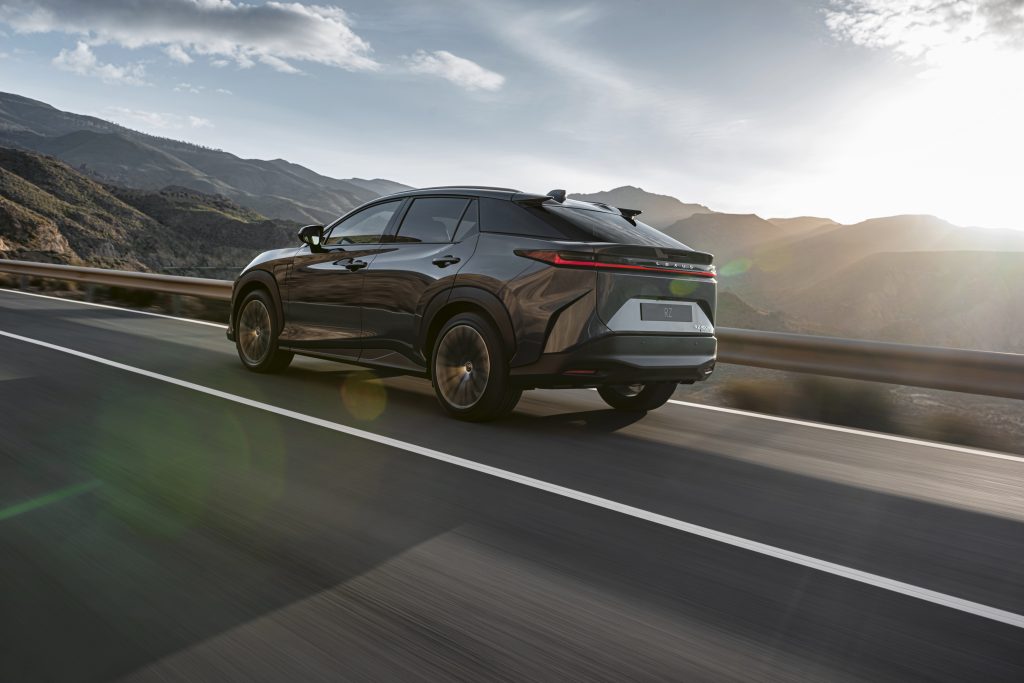









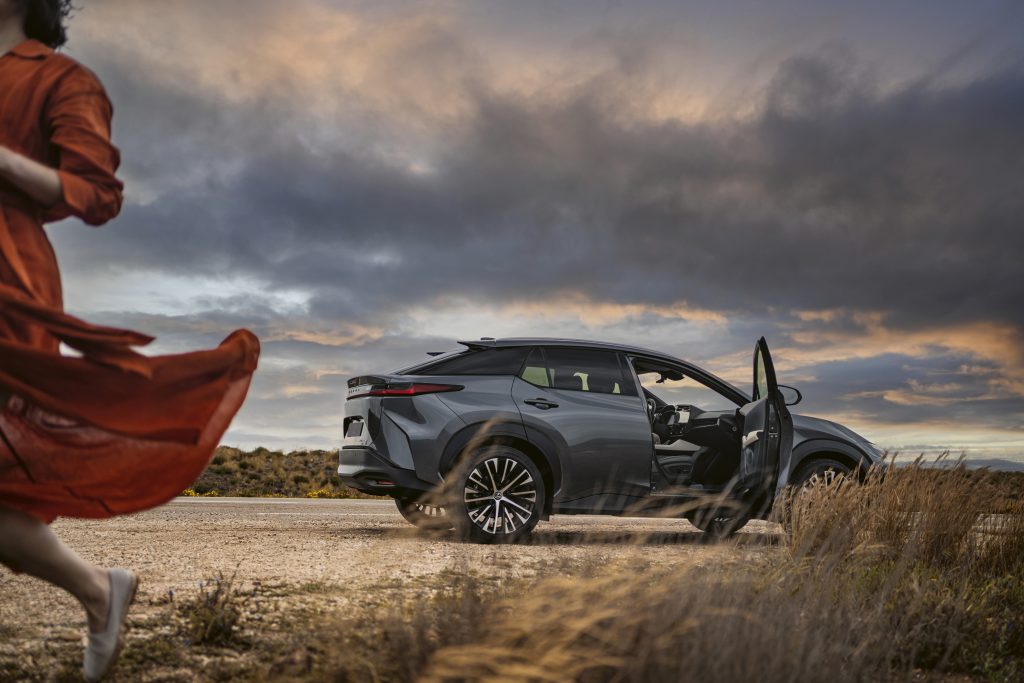







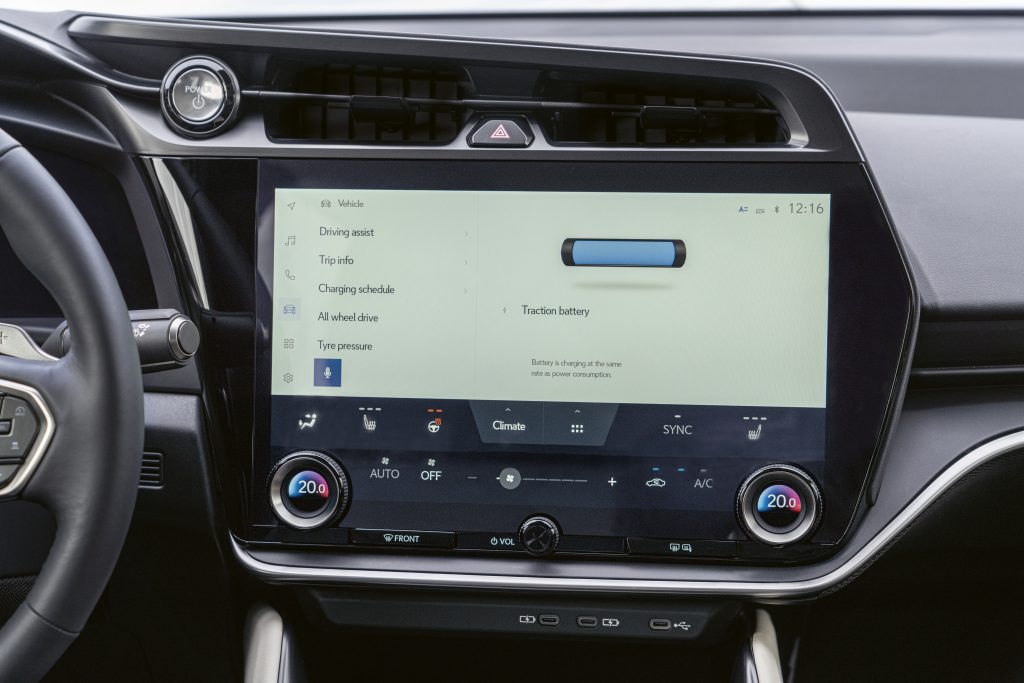


LIFE ON BOARD
Interior design and the Tazuna concept
The RZ’s cockpit is an evolution of the Tazuna concept. This brings together the driver’s position at the wheel and the precise arrangement of the meters, controls and displays to create a space where only small movements of hand and eye are required operate the vehicle. The principle is inspired by the small adjustments of the reins a rider uses to control a horse – the meaning of “Tazuna” in Japanese. With the introduction of the optional One Motion Grip (detailed above), the full benefits of the Tazuna driver cockpit philosophy can be realised.
The arrangement of the meters, head-up display and 14-inch multimedia display has been optimised and the instrument panel has been set low, further improving the driver’s forward sightline. The designers also interpreted the BEV performance in a clean and minimalistic look with fewer elements and less ornamentation, while still using high quality materials. The centre console features a new dial-type control for the shift-by-wire system, reflecting the overall design simplicity.
The cabin is designed as a light and open space, enhanced by ambient lighting with a wide spectrum of selectable colours to suit the mood of the journey. Lexus has also created a new illumination effect, In-ei, which produces different effects from with patterns of light and shadow across the door panels.
Advanced technology features
Lexus has introduced a number of human-centred advanced technology features in the RZ that enhance comfort, convenience, and life on board, reinforcing the spirit of Omotenashi hospitality.
Two are Lexus firsts: a dimmable panoramic roof with a special coating to reduce heat radiation, and a radiant heating system for the driver and front passenger.
Dimmable panoramic roof
The optional panoramic roof increases the feeling of space and light in the cabin. The glass has a low-e (low-emissive) coating that reflects infra-red radiation and reduces radiant heat on sunny days, while helping keep heat inside the cabin when the weather is cold. The roof also has an electric dimming function, which instantly switches from transparent to opaque with a simple touch control, cutting out any direct sunlight.
As a result, there is less need to use the air conditioning system to maintain a comfortable temperature and there is no need for a retracting sunshade, which saves weight – factors that reduce the RZ’s energy use and help maintain its driving range.

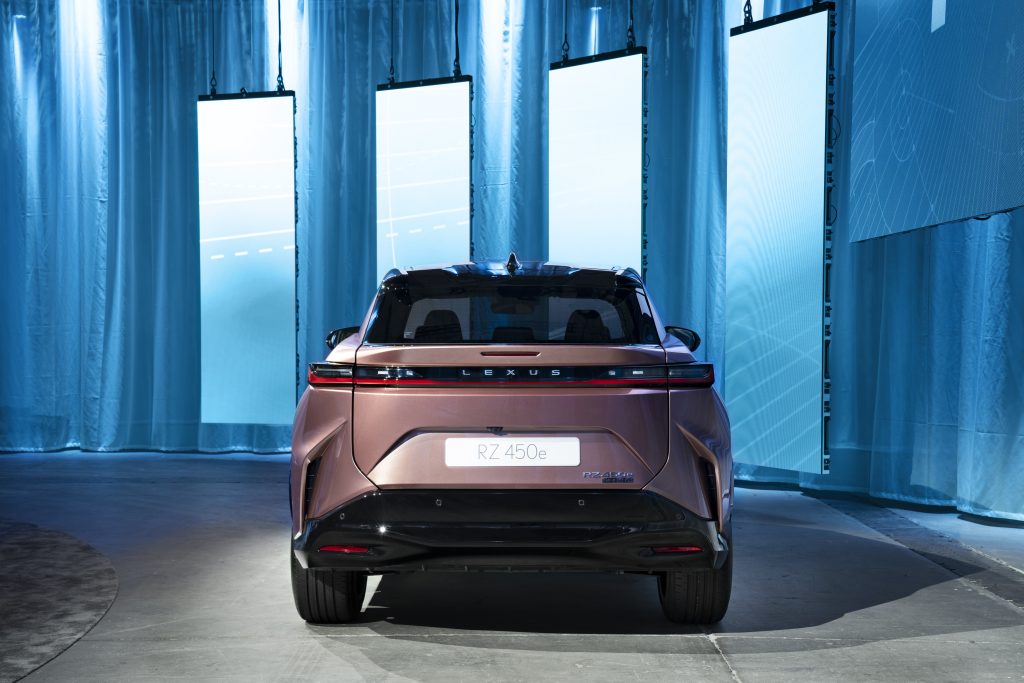



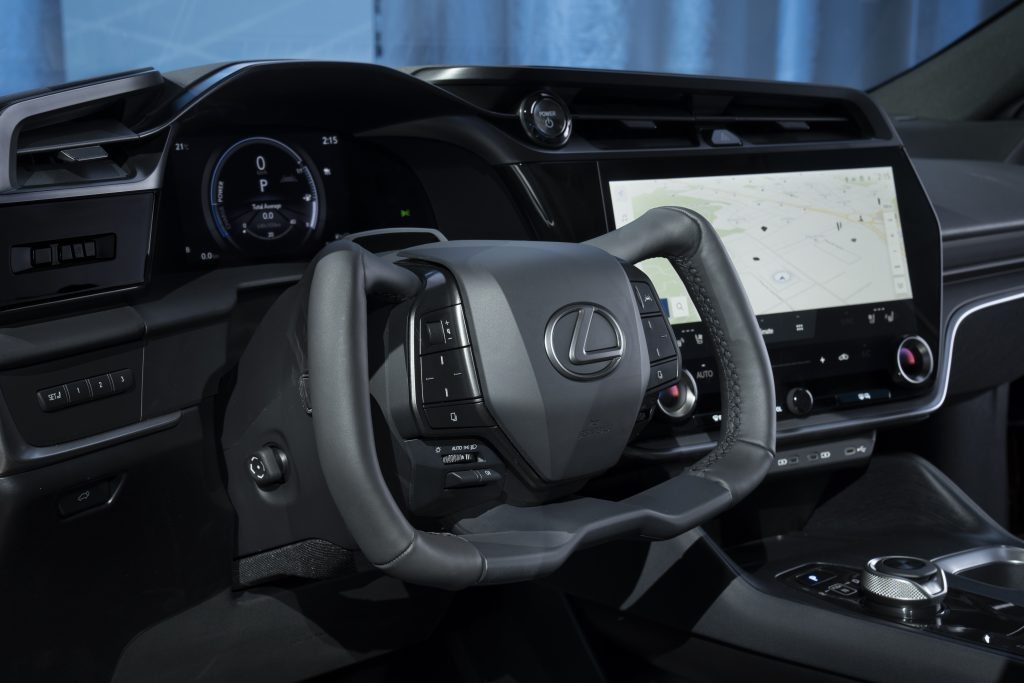







Radiant heaters
New radiant heaters are positioned at knee-level in front of the driver and front passenger, beneath the steering column and lower instrument panel. Provided in addition to seat heaters and a heated steering wheel, they help speed up warming for the driver and front passenger, generating the feeling of a warm blanket around the legs. Just as with the panoramic roof, they help save energy, reducing the load on the air conditioning system.
Multimedia system
The RZ is equipped with the all-new Lexus Link multimedia platform, with faster, more intuitive operation and increased functions for connectivity, efficient journey planning and information.
The system, which debuted in the new Lexus NX, includes “always on” cloud-based navigation, benefiting from up-to-the moment information on traffic events, accidents, and road conditions. The voice recognition function understands and responds to conversational requests and is able to detect commands when there is background noise. There is also a new “Hey Lexus” on-board assistant, and smartphone integration is enabled via Apple CarPlay and Android Auto.
The vehicle’s DCM (data communication module) allows functions to be conveniently updated or added over the air, without any interruption to the vehicle’s use.
SAFETY AND DRIVER ASSISTANCE
The RZ benefits from the advanced active safety and driver assistance systems featured in the latest, third generation of Lexus Safety System + with upgraded and additional functions and increased scope for accident risk detection.
Further advances introduced with the new RZ include Proactive Driving Assist with steering assist and a new monitor to check driver behaviour for signs of fatigue or distraction. Proactive Driving Assist uses the front camera to determine the angle of a bend, adjusting the steering appropriately when approaching and making a turn.
e-Latch system with Safe Exit Assist
The RZ is equipped with Lexus’ e-Latch, a smooth, one-touch electronic door release system. Its operation is linked to the car’s Blind Spot Monitor to provide Safe Exit Assist., which automatically cancels the door opening if vehicles or cyclists are detected approaching from the rear. Developed as a world-first, it is expected to help prevent 95% of accidents caused by door opening.
A digital rear-view mirror is also available, giving the driver a clearer view with no obstruction from headrests or luggage, and improved vision at night and in poor weather conditions.
 2441
2441





